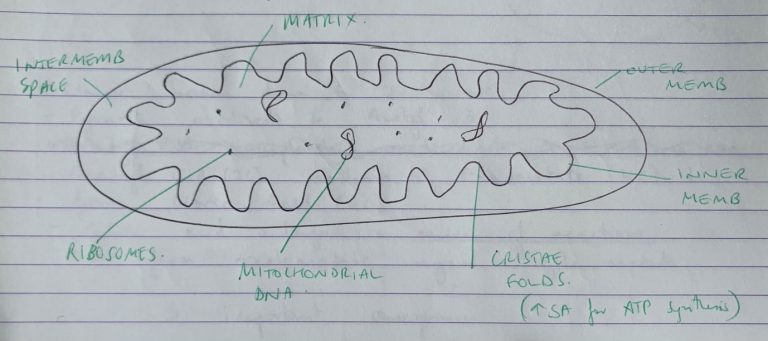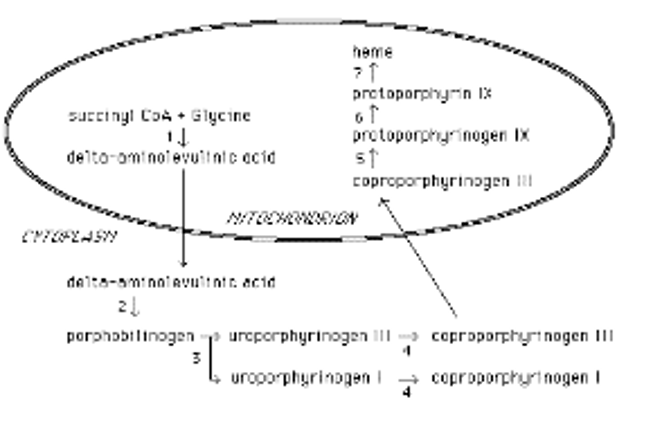Ei / 16A18: Describe the structure and function of the mitochondrion
16A18: Exam Report
Describe the structure and function of the mitochondrion.
19% of candidates passed this question.
Most candidates had at least a basic understanding of mitochondral function although some detail was required for a pass and many did not provide this. A well labelled diagram was used by many candidates and scored marks. Repetition of the same information illustrated on a labelled diagram in subsequent text was not required and did not score additional marks.
It was expected answers would cover basic structure (double membrane structure with cristae and enzymes lining the membrane and within the matrix), details of the electron transport chain, the citric acid cycle and beta-oxidation of long chain fatty acids and mention the maternal origin of DNA. Better Answers provided some information on other functions such as
production of reactive oxygen species, role in calcium homeostasis and apoptosis, urea cycle, haem synthesis and heat production
Ei / 16A14: Describe the structure and function of the mitochondrion
Definition
Mitochondria are a double-membrane bound organelle found in almost all eukaryote organisms
Diagram

Structure
- Size 0.5-1 micrometer in length
- Found in cytoplasm of eukaryotic cells
- 3 distinct membranes:
- Outer member
- Porous
- Freely traversed by ions and small uncharged molucles
- Cannot maintain a membrane potential
- Inner membrane
- Tight diffusion barrier to all ions and molecules
- Huge amount of membrane proteins
- Protein carriers select for ion/molecule
- Generates an electrochemical membrane potential of 180mV
- The site of oxidative phosphorelation
- Cristae membrane(s) which are attached to the inner boundry membrane
- Outer member
- Therefore, there are 3 potential spaces each with differing protein contents:
- The inter membrane space
- The intracristal space
- The Matrix Space
- Equivalent to cytoplasm
- pH 7.9-8
- creates the trans-membrane electrochemical gradient that drives ATP synthesis
- Site of DNA replication, transcription, protein synthesis
- Site of Citric Acid Cycle
Cristae
- Cristae are inner membrane invaginations
- Travel deep into the matrix
- Crista membranes contain most of the enzymes of the ETC and ATP synthase
- Contain large amounts of Cytochrome c
- The primary site of biological energy converstion for all non-photosynthetic eukaryotes
Maternal DNA
- Mitochondria replicate DNA by binary fission
- Their DNA has maternal lineage
Function
Citric Acid Cycle
- Eukaryotes use Citric Acid Cycle to meet energy needs
- Occurs in mitochondrial matrix
- Glucose broken down to 2 pyruvate
- Pyruvate oxidised to Acetyl CoA
- Acetyl CoA (2C) combines w Oxaloacetate (4C) to form Citric Acid (6C)
- Citric Acid undergoes a series of reactions to form Oxaloacetate again → cycle repeats
- 3 important consequences:
- 1 ATP for every Citric Acid entering cycle
- For each Citric Acid, 8 Hydrogen atomes with high-energy electrons are transferred to FAD & NAD+ (hydrogen carriers)
NAD+ + 2H → NADH + H+
FAD + 2H → FADH2
- 2CO2 produced
- The cycle repeats as long as there is Pyruvate & O2
- Electrons are transferred from NADH/FADH2 to O2, which is why, although O2 doesn’t participate directly in Citric Acid cycle, it will only work in aerobic conditions
ETC
- Mitochondria are the main source of ATP
- ATP is produced on a massive scale
- A healthy adult produces 50kg of ATP a day!
- Electron Transport Chain occurs on cristae inner membrane
- Hydrogens donate pairs of electrons to molecular O2 and a large amount of free energy is liberated to make ATP
- Electrons are passed down the electron chain via a series of enzymes that pass the energy from one enzyme to another, the electron energy decreases and this is transferred to ATP
- Generates 36 ATP
mROS
- Mitochondrial reactive oxygen species are produced on the inner mitochondrial membrane during oxidative phosphorylation
Calcium Homeostasis
- Calcium signalling is a universal mechanism by which extracellular messengers alter activity of their target cells
- Being the ‘power house’ of a cell, the mitochondria has huge involvement in intraceullar calcium homeostasis
- Inner & Outer mitochondrial membranes have channels and exchangers which regulate mitochondrial calcium transport
- These channels are closely located to the ER & SR, allowing very high rates of calcium uptake
- This also allows a huge amount of intraceullular calcium buffering by mitochondria
- Calcium accumulation in mitochondria → stimulates aerobic metabolism & ATP production through modulation of TCA enzymes
- Depletion of calcium → decreases ATP production to promote pro-survival autophagy
- Very high levels of intracellular calcium can trigger cell death by apoptosis
Apoptosis
- Cellular apoptosis involved the regulation of caspases – cysteine proteases that can cleave many cellular substrate to dismantle cell contents
- Caspases exist in the inactive form (proenzymes)
- During apoptosis a procaspase in cleaved to reveal the active enzyme
- Activation of caspases is by two pathways; extrinsic and intrinsic (mitochondrial)
- Mitochondria essential for intrinsic pathway activation
- Release pro-apoptotic factors which result in cleavage of procaspase to induce apoptosis
Urea Cycle
- The Ornithine cycle converts excess ammonia to urea in the mitochondria of hepatocytes
Haem Synthesis
- Begins in mitochondria and is completed in cytoplasm
- Begins with condensation of succinyl-CoA + Glycine

Heat Production
- During massive amounts of ATP production, energy which is lost dissipates as heat
- Author: Krisoula Zahariou